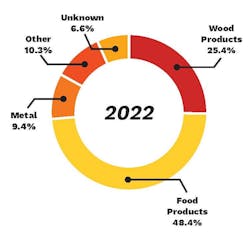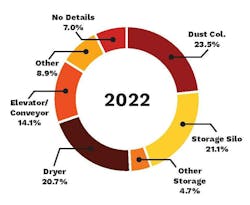2022 Combustible Dust Incident Report summary

On May 2, 1878, the Washburn A mill exploded in Minneapolis, Minnesota, tragically taking the lives of 18 people and destroying one-third to one-half of the city's flour production capacity. One hundred and thirty years later, in 2008, a similar dust explosion occurred a refinery owned by Imperial Sugar in Port Wentworth, Georgia, resulting in 14 deaths and 36 injuries. Despite all that time having passed, it seemed as if little progress had been made in combustible dust safety.
The reason for this lack of progress is that we tend to forget. After the investigations are complete and the victims are memorialized, we go back to business as usual. We also assume that it will never happen at our facility, so we hesitate to invest in safety moving forward. As a result, companies continue to downplay the risk, and history keeps repeating itself.
The reality is that combustible dust fires and explosions continue to be a global hazard. At Dust Safety Science, we focus on understanding the scale of these incidents and finding effective ways to prevent the resulting damage to property, and more critically, the loss of life and injury.
In this respect, our 2022 Combustible Dust Incident Report is more than just a collection of data. It is a crucial resource aimed at spreading awareness and improving safety standards in industries where combustible dust is a concern. Through this report, we aim to highlight the key areas of risk and offer actionable insights that can help to reduce these hazardous incidents.
Incident data overview
The data presented in the report shows a fluctuating yet concerning trend in combustible dust incidents from 2018 to 2022. In 2022 alone, there were 163 fires, 50 explosions, 89 injuries, and 49 fatalities recorded. These figures, although slightly lower than previous years, highlight the ongoing risk and impact of combustible dust incidents in various sectors.
Loss history in the United States
The United States has experienced a significant number of dust explosions over the past seven years, with an average of 29 explosions recorded in the database per year. These incidents have led to an average of 26 injuries per year, with fatalities ranging from one to seven annually. This data underscores the persistent risk and impact of combustible dust incidents in American industries and is likely a bare minimum of what is happening, as most incidents are not reported.
Materials involved
In 2022, various materials were involved in combustible dust incidents. Wood products accounted for 25.4%, food products for 47.4%, and metal dust for 10.8% of the incidents. Notably, coal dust, while only accounting for 5% of recorded incidents, was responsible for 31% of injuries and 84% of fatalities, largely due to a mine explosion in Turkey. This highlights the disproportionate impact certain materials can have in terms of injuries and fatalities.
Analysis of fire and explosion incidents by industry
The report presents a detailed breakdown of dust-related fire and explosion incidents by industry:
- In wood processing industries such as furniture production and plywood manufacturing, there were 43 fires and 9 explosions, resulting in 4 injuries and 2 fatalities.
- The food industry saw 84 fires, 19 explosions, 22 injuries, and 3 fatalities.
- In the metal sector, the incidents were fewer but equally impactful, with 13 fires, 7 explosions, 22 injuries, and 2 fatalities.
- The coal industry, despite fewer incidents, had a higher number of casualties, with 5 fires, 6 explosions, 28 injuries, and a staggering 41 fatalities.
These figures reveal the varying degrees of risk associated with different materials in various industry sectors. For instance, in the wood and wood products industry, there has been a consistent presence of fires and explosions, underlining the need for targeted safety measures in these sectors. Similarly, the agricultural and food production sectors have seen a considerable number of incidents, although injuries and fatalities have been relatively lower compared to other materials such as coal and metal dust.
Equipment and causes
Dust collectors were identified as the primary source of combustible dust incidents in 2022, accounting for 24% of the incidents. (Storage silos and dryers were also significant contributors.)
Dust collectors were not only the most common source of incidents but also led to the highest number of injuries and fatalities. The report points out that seven dust collector explosions and four fires combined to cause 15 injuries and five fatalities. This data highlights the critical need for proper maintenance and safety practices around such equipment.
Incident examples
On February 5, 2022, a fire and explosion occurred at a grain elevator in Clovis, New Mexico. One firefighter suffered a broken arm during response efforts. The incident was likely caused by a combination of welding work and accumulated grain powder in the ductwork.
On October 18, 2022, an explosion and fire broke out at an aerospace parts manufacturer in Niles, Ohio. Two contractors were removing titanium dust from a unit when the dust ignited, resulting in both suffering burn injuries.
On November 17, 2022, a dust explosion occurred at a bicycle parts manufacturer in Fuxing Township, Changhua County, Taiwan. The incident, which apparently occurred near the dust collection area, seriously injured three employees.
OSHA citations and compliance
The 2022 report also sheds light on the enforcement actions taken by OSHA in response to combustible dust hazards. Throughout the year, several industries faced OSHA citations for violations related to dust safety. The violations were spread across various sectors, including:
- Farm machinery manufacturing
- Graphic design services
- Warehousing
- Wood product manufacturing
The total initial penalties amounted to more than $1 million, indicating the seriousness with which OSHA is treating combustible dust-related infractions.
Implications of the report
This report is intended as a call to action for industries handling combustible materials. The data stresses the need for continuous improvement in safety practices, regular training for workers, and closer adherence to regulatory standards. Despite advancements in technology and safety protocols, the risk of combustible dust incidents remains significant, and prevention requires ongoing attention and effort.
Future outlook
The 2022 Combustible Dust Incident Report provides a vital insight into the risks associated with combustible dust in various industries. It highlights the need for sustained awareness, robust safety measures, and strict compliance with regulations to mitigate these risks. It also serves as a reminder of the catastrophic consequences of neglecting dust explosion hazards and the importance of learning from past incidents to ensure a safer future.
Download all of the Combustible Dust Incident Reports from 2016 to 2022 at https://dustsafetyscience.com/report-download.
Chris Cloney is managing director and Rose Keefe is technical writer at Dust Safety Science.
Dust Safety Science
dustsafetyscience.com
About the Author
Rose Keefe
Rose Keefe is technical writer at Dust Safety Science.
Chris Cloney
Chris Cloney is managing director at Dust Safety Science.


